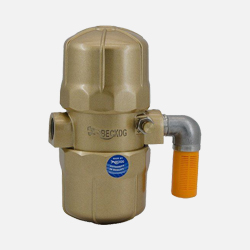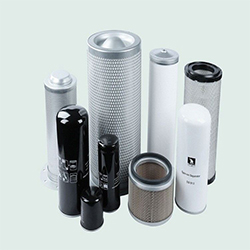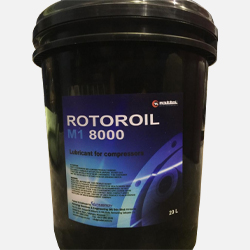Services
Compressed Air System
A compressed air system is a mechanical system that generates, stores, and distributes compressed air for various applications. It involves several components working together to produce, store, and deliver pressurized air.
Here’s a basic explanation of how a compressed air system works:
-
Air Compressor: The process begins with an air compressor, which is typically an electric motor or a combustion engine-driven device. The air compressor draws in atmospheric air and compresses it, reducing its volume and increasing its pressure. There are different types of compressors, including reciprocating compressors, rotary screw compressors, and centrifugal compressors.
-
Intake and Filtration: The air compressor pulls in air through an intake system, which usually includes an air filter to remove contaminants such as dust, dirt, and moisture. The filtration process helps protect the compressor and downstream equipment from damage.
-
Compression: The air is compressed by the compressor’s action. In a reciprocating compressor, a piston moves back and forth within a cylinder, compressing the air. In a rotary screw compressor, two interlocking helical screws rotate, squeezing and compressing the air. In a centrifugal compressor, air is accelerated by a high-speed impeller, converting kinetic energy into pressure.
-
Cooling: The compression process generates heat, so most air compressors include a cooling system to prevent overheating. This can involve air or water cooling methods, which help remove excess heat from the compressed air.
-
Air Receiver Tank: After compression, the pressurized air is typically stored in an air receiver tank, also known as an air storage tank. The tank acts as a reservoir, providing a steady supply of compressed air during peak demand periods and allowing the compressor to cycle on and off less frequently. The tank also helps to smooth out pressure fluctuations and acts as a condensate separator, allowing moisture to settle at the bottom for drainage.
-
Air Treatment: Compressed air often requires further treatment before it can be used in various applications. This may involve additional filtration to remove residual moisture, oil, and other contaminants. Air dryers are commonly used to reduce the humidity in the compressed air, preventing corrosion and damage to equipment.
-
Distribution: Once the compressed air is properly treated, it is distributed through a network of pipes or hoses to the desired points of use. Valves, regulators, and pressure gauges may be installed to control and monitor the air flow and pressure at different locations.
- Application: The compressed air is finally used for a wide range of applications, such as powering pneumatic tools, operating machinery, providing ventilation, driving air motors, and more.

Compressed Air System Troubleshooting & Overhaul
Troubleshooting and overhauling a compressed air system are crucial for ensuring its efficient and reliable operation. Here are some reasons highlighting the importance of these activities.
-
System Performance Optimization: Troubleshooting and overhauling help identify and address issues that may affect the performance of a compressed air system. By identifying and rectifying problems such as leaks, pressure drops, or inefficient equipment, the system can be optimized to deliver the desired output. This leads to improved productivity and energy efficiency.
-
Cost Savings: Identifying and fixing issues in a compressed air system can result in significant cost savings. For example, addressing air leaks can prevent unnecessary energy waste and reduce electricity bills. Troubleshooting and overhauling also help identify and correct inefficient system components, reducing maintenance and replacement costs in the long run.
-
Reliability and Downtime Reduction: Regular troubleshooting and overhauling help identify potential system failures before they occur. By addressing issues proactively, the risk of unexpected breakdowns and costly downtime is minimized. This ensures continuous operation, reduces production interruptions, and enhances overall system reliability.
-
Plumbing and Sanitary Systems: In residential, commercial, and institutional buildings, proper pipe installation is crucial for plumbing and sanitary systems. Pipes are used to supply clean water to buildings, carry wastewater away, and facilitate the functioning of toilets, sinks, showers, and other plumbing fixtures. Adequate pipe installation ensures reliable water supply, efficient drainage, and proper sanitation, contributing to the health and well-being of occupants.
-
Safety and Compliance: A properly functioning compressed air system is essential for ensuring a safe working environment. Troubleshooting and overhauling activities help identify and rectify potential safety hazards, such as faulty pressure relief valves or improper filtration systems. Additionally, regular maintenance and overhauling ensure compliance with relevant industry regulations and standards.
-
Extended Equipment Lifespan: By regularly troubleshooting and overhauling a compressed air system, you can identify and address issues that may contribute to premature wear and tear of system components. Proper maintenance and timely repairs can extend the lifespan of equipment, reducing the need for frequent replacements and associated costs.
- Energy Efficiency: Troubleshooting and overhauling activities focus on optimizing system performance and reducing energy wastage. By identifying and rectifying issues such as air leaks, improperly sized equipment, or inefficient control mechanisms, the overall energy efficiency of the compressed air system can be improved. This results in lower energy consumption and reduced environmental impact.

Compressed Air System Pipe Installation
Pipe installation plays a vital role in various industries and sectors, ranging from plumbing and construction to industrial processes and infrastructure development.
Here are several key reasons why pipe installation is important:
-
Fluid Conveyance: Pipes are essential for the transportation of fluids, such as water, gas, oil, chemicals, and other liquids or gases. They create a network of interconnected channels that enable the transfer of these substances from one location to another. Whether it’s supplying water to households, distributing fuel in industrial settings, or conveying chemicals in a manufacturing facility, pipes are critical for efficient fluid transport.
-
Infrastructure Development: Pipe installation is a fundamental aspect of infrastructure development. It is necessary for constructing and maintaining various systems, including water supply networks, sewerage and drainage systems, irrigation systems, and telecommunications networks. These systems form the backbone of modern society, supporting the needs of communities, businesses, and industries.
-
Plumbing and Sanitary Systems: In residential, commercial, and institutional buildings, proper pipe installation is crucial for plumbing and sanitary systems. Pipes are used to supply clean water to buildings, carry wastewater away, and facilitate the functioning of toilets, sinks, showers, and other plumbing fixtures. Adequate pipe installation ensures reliable water supply, efficient drainage, and proper sanitation, contributing to the health and well-being of occupants.
-
Industrial Processes: Pipes are extensively used in industrial settings to facilitate various processes. They are employed in manufacturing plants, refineries, power plants, and other industrial facilities for the conveyance of raw materials, intermediate products, and final products. Additionally, pipes are essential for cooling systems, steam distribution, compressed air lines, and other utilities required in industrial operations.
-
Safety and Efficiency: Proper pipe installation is essential for ensuring safety and efficiency. Pipes must be correctly sized, positioned, and supported to prevent leaks, bursts, or other failures that can lead to accidents, property damage, or environmental hazards. Accurate installation techniques and adherence to industry standards and regulations help maintain system integrity and optimize the overall performance of the piping network.
-
Longevity and Durability: Quality pipe installation, combined with the use of suitable materials, enhances the longevity and durability of piping systems. Well-installed pipes can withstand the intended operating conditions, including pressure, temperature, and environmental factors, without experiencing premature degradation or failure. This reduces maintenance requirements, minimizes downtime, and contributes to the long-term reliability of the system.
- Future Adaptability: Proper pipe installation takes into account the potential for future expansion or modifications. It allows for the integration of additional pipelines, valves, fittings, and other components as needed. This flexibility enables the system to accommodate changes in demand, technology advancements, or evolving operational requirements without significant disruptions or costly reconfigurations.

Compressed Air System Chemical Cleaning
Chemical cleaning of air receiver tanks is an effective method to remove accumulated deposits, contaminants, and rust from the tank’s internal surfaces. It helps to improve the tank’s efficiency and prolong its lifespan.
Here’s a general overview of the process:
-
Safety Precautions: Before starting any cleaning procedure, ensure you follow all safety guidelines. Wear appropriate protective gear, including gloves, goggles, and a respirator if required. Ventilate the area adequately to prevent the accumulation of harmful fumes.
-
Tank Preparation: Shut down the air compressor and release all pressure from the tank. Close all valves and disconnect any external connections. Ensure the tank is completely isolated from the compressed air system.
-
Drainage: Open the drain valve to release any accumulated water, oil, or other liquids from the tank. Dispose of these fluids according to local regulations.
-
Chemical Solution Preparation: Prepare a suitable chemical cleaning solution. The specific solution may vary based on the type of contaminants present, but a common option is a mixture of water and a commercial cleaning agent or detergent. Follow the manufacturer’s instructions for the proper dilution ratio.
-
Circulation: Fill the tank with the cleaning solution and circulate it throughout the tank. You can use a pump or the compressor itself to circulate the solution. Ensure the solution reaches all areas of the tank, including baffles and corners.
-
Soaking: Allow the cleaning solution to soak in the tank for a sufficient period, typically around 2-4 hours. This allows the chemicals to break down deposits and loosen contaminants.
-
Agitation: If necessary, use mechanical or manual means to agitate the solution inside the tank. This helps dislodge stubborn deposits and facilitate the cleaning process. Be cautious not to damage the tank’s internal surfaces.
-
Draining and Flushing: After the soaking period, drain the cleaning solution from the tank. Flush the tank thoroughly with clean water to remove any residual chemicals or loosened debris. Repeat this step as necessary until the water runs clear.
-
Drying: Allow the tank to dry completely before reconnecting it to the compressed air system. Proper drying helps prevent the formation of new deposits or corrosion.
- Inspection and Maintenance: Once the tank is dry, inspect its internal surfaces for any remaining deposits or signs of damage. If necessary, perform additional cleaning or maintenance tasks to ensure optimal performance.

Rental and Leasing Compressed Air Systems
Rental and leasing options for compressed air systems offer several benefits to businesses. There are many benefits and advantages.
-
Cost-effectiveness: Renting or leasing a compressed air system can be more cost-effective than purchasing one outright. It eliminates the need for a significant upfront investment, which is especially beneficial for small and medium-sized businesses with budget constraints. Renting or leasing allows businesses to access high-quality equipment without the burden of ownership costs, such as maintenance, repairs, and depreciation.
-
Flexibility: Rental and leasing agreements provide flexibility to businesses. They can choose the duration of the rental or lease period based on their specific needs, whether it’s a short-term project or a long-term requirement. Flexibility also extends to upgrading or downsizing the equipment as per changing needs without the hassle of selling or buying new equipment.
-
Reduced maintenance and repairs: When you rent or lease a compressed air system, the rental or leasing company typically takes care of maintenance and repairs. This can save your business significant time and money, as the responsibility for servicing and upkeep lies with the rental or leasing provider. Regular maintenance ensures the equipment operates efficiently and reduces the risk of unexpected breakdowns.
-
Access to advanced technology: Compressed air system technology evolves over time, with new advancements aimed at increasing energy efficiency and productivity. Renting or leasing allows businesses to access the latest equipment and technologies without the need to invest in frequent upgrades. This ensures that your operations remain competitive and efficient by utilizing state-of-the-art compressed air systems.
-
Scalability: Renting or leasing offers scalability to businesses that may experience fluctuations in their compressed air system requirements. If your business experiences a temporary increase in production or requires additional capacity for a specific project, you can easily scale up by renting additional equipment. Similarly, during periods of reduced demand, you can scale down by returning or downsizing the rented or leased equipment.
-
Expert support: Rental and leasing providers often offer technical support and expertise to ensure optimal performance of the compressed air systems. Their teams of professionals can assist with installation, system optimization, troubleshooting, and other technical issues. This support can be invaluable, particularly for businesses without in-house expertise in compressed air systems.
- Risk mitigation: By renting or leasing a compressed air system, businesses transfer the risk associated with equipment ownership to the rental or leasing provider. This includes risks related to equipment obsolescence, technological changes, and unexpected breakdowns. Additionally, rental and leasing agreements often include clauses for equipment replacement or repairs in case of failure, minimizing downtime for your operations.

Compressed Air Systems Energy Audit
The Energy Audit provides the vital information for overall energy conservation program covering essentially energy utilization analysis and evaluation of energy conservation measures. It aims at: Identifying the quality and cost of various energy inputs.
Performing an energy audit is of paramount importance for various reasons, especially in today’s world where energy conservation and sustainability are critical goals. As an energy audit specialist, your role is to assess and analyze energy usage in various settings, such as residential, commercial, or industrial, and provide recommendations for improvements. Here are some key reasons why performing an energy audit is crucial:
-
Cost Savings: Energy costs are a significant expense for individuals and organizations. Energy audits can identify areas where energy is being wasted, allowing for cost-effective solutions to reduce energy consumption and lower utility bills. This directly translates into financial savings, which can be substantial over time.
-
Environmental Impact: Energy consumption is closely linked to greenhouse gas emissions and environmental degradation. By identifying energy inefficiencies and implementing energy-saving measures, energy audits contribute to reducing an organization’s carbon footprint and overall environmental impact. This is crucial in addressing climate change and promoting sustainability.
-
Regulatory Compliance: Many regions and industries have regulations and standards in place to encourage energy efficiency and reduce emissions. Performing energy audits helps organizations ensure compliance with these regulations, avoiding potential penalties and legal issues.
-
Equipment Efficiency: Energy audits assess the performance of equipment and systems, including HVAC systems, lighting, appliances, and industrial machinery. Identifying and rectifying issues with equipment efficiency can extend their lifespan, reduce maintenance costs, and improve overall operational reliability.
-
Improved Comfort and Productivity: In residential and commercial settings, optimizing energy usage can lead to improved indoor comfort and productivity. Proper lighting, heating, and cooling can create a more comfortable environment for occupants, resulting in enhanced well-being and increased productivity.
-
Energy Resilience: Energy audits can identify vulnerabilities in energy systems and suggest measures to enhance energy resilience. This is particularly important in critical facilities like hospitals, data centers, and manufacturing plants, where uninterrupted energy supply is essential.
-
Risk Mitigation: Energy audits can uncover potential risks related to energy consumption, such as electrical hazards, equipment malfunctions, and inefficient processes. Addressing these risks proactively can prevent accidents and unplanned downtime.
-
Energy Conservation: In an era of growing energy demand and resource scarcity, conserving energy resources is crucial. Energy audits promote responsible energy consumption and contribute to the long-term sustainability of energy resources.
- Competitive Advantage: Organizations that prioritize energy efficiency and sustainability often enjoy a competitive edge in the marketplace. Energy audits can help businesses differentiate themselves, attract environmentally conscious customers, and meet corporate social responsibility goals.

Commercial HVAC System
HVAC stands for Heating, Ventilation, and Air Conditioning. It refers to the technology and systems used to provide thermal comfort and acceptable indoor air quality in buildings, vehicles, and other enclosed spaces. The primary purpose of HVAC systems is to regulate and control temperature, humidity, airflow, and air quality to create a comfortable and healthy environment for occupants.
Here are a few reasons why good quality HVAC is important in manufacturing industries:
-
Temperature Control: Manufacturing processes often require specific temperature ranges for optimal operation. HVAC systems can regulate and maintain the desired temperature levels, ensuring that the production environment remains consistent and conducive to the manufacturing processes. This helps prevent variations in product quality and minimizes the risk of material deformation or damage due to temperature fluctuations.
-
Humidity Control: Some manufacturing processes are sensitive to humidity levels. Excessive humidity can cause problems like corrosion, mold growth, or product spoilage, while low humidity can lead to static electricity buildup and material shrinkage. A well-designed HVAC system can maintain optimal humidity levels, preventing these issues and ensuring product integrity.
-
Ventilation and Air Quality: Adequate ventilation is crucial in manufacturing industries to remove contaminants, odors, and airborne particles generated during the production processes. A high-quality HVAC system can effectively remove pollutants and replace stale air with fresh, filtered air, promoting a healthier and safer work environment for employees. Good air quality is essential for the well-being and productivity of the workforce.
-
Equipment Performance and Longevity: HVAC systems also play a vital role in maintaining the performance and longevity of manufacturing equipment. Excessive heat or poor ventilation can lead to overheating, which can cause equipment failures, reduced efficiency, and increased maintenance costs. By providing proper cooling and airflow, a quality HVAC system helps prevent equipment breakdowns, prolongs their lifespan, and ensures smooth and efficient manufacturing operations.
- Energy Efficiency: A well-designed and properly maintained HVAC system can significantly contribute to energy efficiency in manufacturing facilities. Energy-efficient HVAC equipment and controls can help reduce energy consumption, resulting in lower utility bills and a reduced carbon footprint. Moreover, energy-efficient systems often qualify for incentives or rebates, providing potential cost savings for manufacturers.













